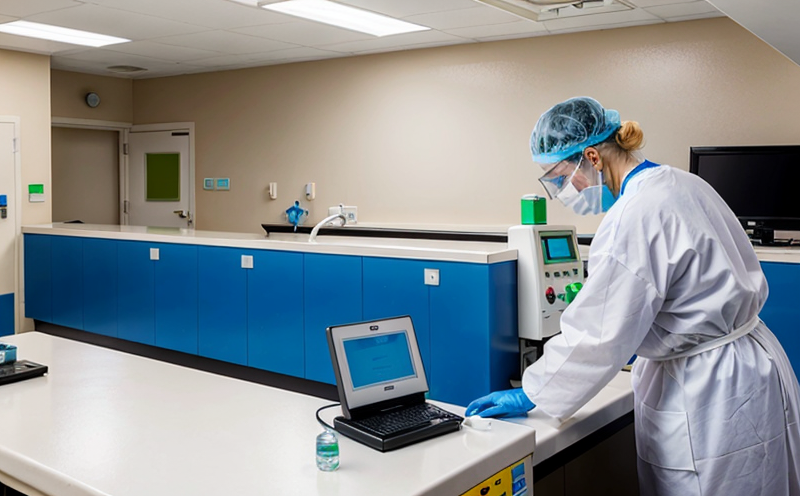Biofilm Detection Testing in Hospital Water Pipelines
Biofilm detection testing is a critical procedure within the realm of hospital hygiene and environmental monitoring. Biofilms, composed of microorganisms adhering to surfaces in aqueous environments, can pose significant health risks when present in hospital water systems. The presence of biofilms can lead to the proliferation of opportunistic pathogens such as Pseudomonas aeruginosa or Legionella pneumophila, both of which are linked to increased nosocomial infections and patient morbidity.
The testing process involves several key steps: sampling, preparation, analysis, and reporting. Samples are collected from various points along the water pipeline, including taps, faucets, and showerheads. These samples are then analyzed using advanced microbiological techniques such as culture-based methods or molecular diagnostics like polymerase chain reaction (PCR). The choice of method depends on the specific requirements set by regulatory bodies such as ISO 18178:2015, which provides guidelines for biofilm detection.
The importance of this testing cannot be overstated. Hospitals are densely populated with patients who have compromised immune systems and are at higher risk for infections. By identifying and addressing biofilm formation early, healthcare providers can significantly reduce the incidence of waterborne diseases. This not only improves patient safety but also enhances overall hospital hygiene standards.
Regular monitoring of biofilms is essential to ensure compliance with EN 17348:2019, which mandates that healthcare facilities implement measures to prevent the growth and spread of biofilms in water systems. The testing process helps institutions maintain a high standard of hygiene and adhere to international best practices.
In summary, biofilm detection testing is a proactive measure that plays a crucial role in safeguarding patient health by preventing the spread of pathogens through contaminated water sources within hospital premises.
Why Choose This Test
The decision to implement biofilm detection testing is driven by several compelling factors. Firstly, it ensures compliance with international standards such as ISO 18178:2015 and EN 17348:2019, which provide clear guidelines on the prevention and control of biofilm formation in water systems. Compliance with these standards is not only a legal requirement but also a commitment to patient safety.
- Patient Safety: By detecting and eliminating biofilms early, we reduce the risk of opportunistic infections such as Legionnaires' disease and Pseudomonas sepsis.
- Compliance: Ensuring adherence to international standards is crucial for maintaining a reputable healthcare facility.
- Cost-Effectiveness: Early intervention can prevent more extensive and costly remediation efforts down the line.
Besides these benefits, choosing this test also allows institutions to demonstrate their commitment to quality and patient care. This proactive approach not only protects patients but also enhances the reputation of healthcare providers in the community.
Environmental and Sustainability Contributions
Biofilm detection testing contributes significantly to environmental sustainability by promoting efficient water usage within hospital settings. By identifying areas where biofilms are forming, healthcare facilities can implement targeted measures to reduce water waste and minimize the use of disinfectants. This approach aligns with broader environmental goals, such as reducing energy consumption and chemical runoff into local ecosystems.
Moreover, the detection and control of biofilms help in optimizing water treatment processes, leading to a more sustainable operation overall. By ensuring that water systems are free from harmful microorganisms, hospitals contribute to the health of both their patients and the environment.
In this context, it is important to note that biofilm formation can lead to inefficiencies in water distribution networks. Regular testing allows for the identification and rectification of these issues promptly, thereby enhancing the overall performance of hospital infrastructure.
Use Cases and Application Examples
| Scenario | Description |
|---|---|
| New Hospital Construction | Detect biofilm formation during the construction phase to ensure new systems are free from contamination. |
| Regular Maintenance | Conduct periodic testing to monitor water quality and prevent biofilm growth over time. |
| New Water Treatment Equipment Installation | Evaluate the effectiveness of new equipment in preventing biofilm formation. |
- New Hospital Construction: Before commissioning, testing can ensure that newly installed systems are free from biofilms and other contaminants.
- Regular Maintenance: Routine tests help maintain water quality by identifying early signs of biofilm formation.
- New Water Treatment Equipment Installation: Testing post-installation ensures the new equipment is effective in preventing biofilm growth.
The ability to detect and address biofilms promptly can significantly enhance the reliability and safety of hospital water systems. This proactive approach not only protects patients but also contributes to overall environmental sustainability.





